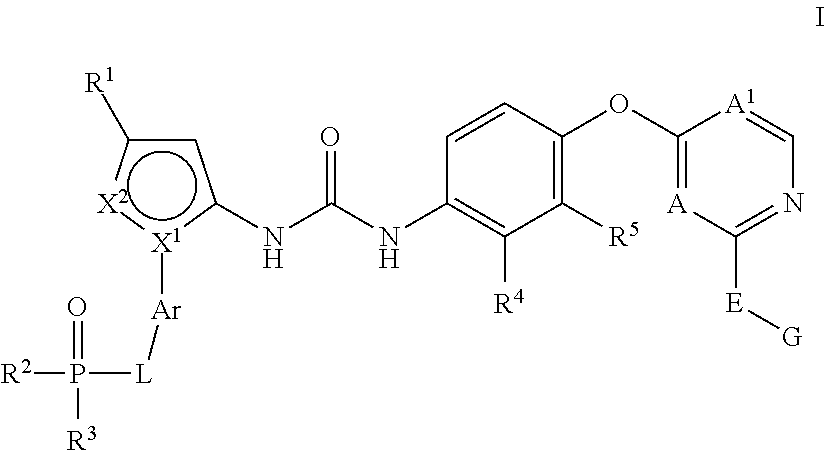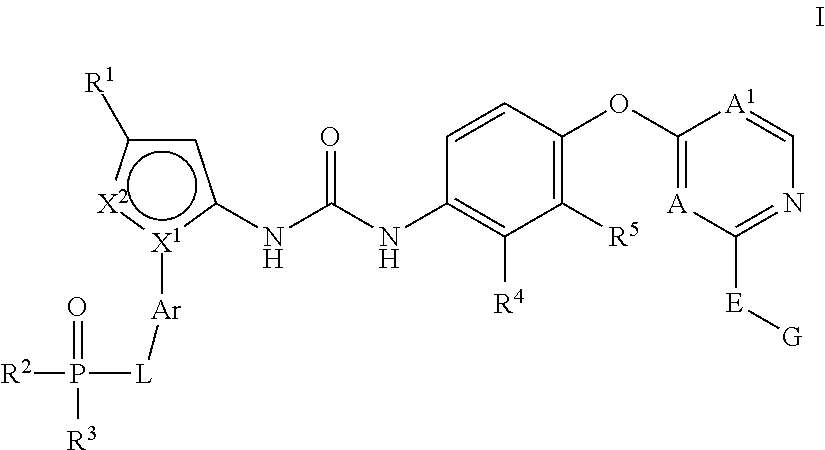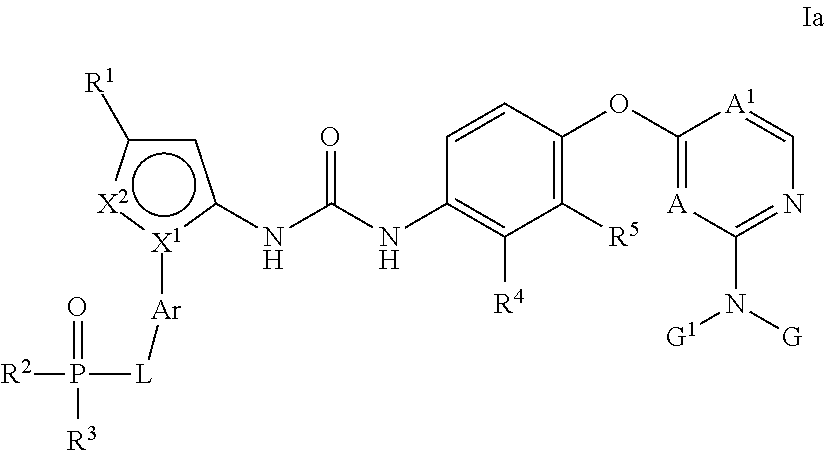Kinase inhibitors
a kinase inhibitor and inhibitor technology, applied in the field of kinase inhibitors, can solve the problems of high toxicity of inhibitors, hindering the utility of p38 map kinase inhibitors in the treatment of human chronic inflammatory diseases, and toxicity observed in patients, and achieve good anti-inflammatory properties
- Summary
- Abstract
- Description
- Claims
- Application Information
AI Technical Summary
Benefits of technology
Problems solved by technology
Method used
Image
Examples
example 1
1-(3-(tert-Butyl)-1-(4-(dimethylphosphoryl)phenyl)-1H-pyrazol-5-yl)-3-(4-((2-(phenylamino) pyrimidin-4-yl)oxy)naphthalen-1-yl)urea
[0413]
(i) 4-((4-Aminonaphthalen-1-yl)oxY)—N-Phenylpyrimidin-2-amine
[0414]p-TSA monohydrate (2.80 g, 14.72 mmol) was added to a stirred mixture of 4-((2-chloropyrimidin-4-yl)oxy)naphthalen-1-amine (see, for example, Cirillo, P. F. et al., WO 2002 / 92576, 21 Nov. 2000; 8 g, 29.4 mmol) and aniline (6.71 mL, 73.6 mmol) in THF (50 mL) at rt under N2. The mixture was heated under reflux for 2 h (reaction mixture solidified), a further 50 mL of THF was added and the mixture heated for a further 2 h. The mixture was cooled, diluted with THF (200 mL), the solid filtered and washed with THF (150 mL). The solid was suspended in DCM (100 mL) and 2M NaOH (35 mL) and the mixture stirred vigorously for 1 h, during which time the solid dissolved. The organic layer was separated, the aq. layer extracted with DCM (100 mL) and the organics combined, dried (MgSO4) and evapora...
example 2
1-(3-(tert-Butyl)-1-(3-(dimethylphosphoryl)phenyl)-1H-pyrazol-5-yl)-3-(4-((2-(phenylamino)pyrimidin-4-yl)oxy)naphthalen-1-yl)urea
[0421]
(i) (3-(5-Amino-3-(tert-butyl)-1H-pyrazol-1-yl)phenyl)dimethylphosphine oxide
[0422]To a solution of 1-(3-bromophenyl)-3-(tert-butyl)-1H-pyrazol-5-amine (250 mg, 0.850 mmol) in DMF (3.5 mL) was added dimethylphosphine oxide (81 mg, 0.935 mmol), palladium(II) acetate (10 mg, 0.045 mmol), Xantphos (32 mg, 0.055 mmol) and K3PO4 (198 mg, 0.935 mmol) and the mixture purged with N2 for 5 min. The reaction was heated in the microwave at 120° C. for 40 min. Reaction was repeated twice. The combined reaction mixtures were partitioned between DCM (150 mL) and water (50 mL), the aqueous layer was extracted with DCM (2×100 mL) and the combined organic layers washed with brine (50 mL), dried (MgSO4) and evaporated under reduced pressure. The crude product was purified by chromatography on silica gel (40 g column, 0-10% MeOH / DCM) to afford the sub-title compound (3...
example 3
N-(4-((4-(3-(3-(tert-Butyl)-1-(4-(dimethylphosphoryl)phenyl)-1H-pyrazol-5-yl)ureido)-naphthalen-1-yl)oxy)pyridin-2-yl)-2-methoxyacetamide
[0427]
[0428]To (4-(5-amino-3-(tert-butyl)-1H-pyrazol-1-yl)phenyl)dimethylphosphine oxide (see Example 1(ii) above; 159 mg, 0.546 mmol) was added a solution of CDI (102 mg, 0.629 mmol) in DCM (1 mL) and the reaction stirred overnight at rt. Solvent was removed under reduced pressure, the residue dissolved in THF (3 mL), N-(4-((4-aminonaphthalen-1-yl)oxy)pyridin-2-yl)-2-methoxy acetamide (see, for example, King-Underwood, John et al. WO 2011 / 121366, 6 Oct. 2011; 88 mg, 0.273 mmol) added and the reaction stirred for 1 h at ambient temperature. The mixture was concentrated under reduced pressure and then purified by chromatography on the Companion (12 g column, 0-10% MeOH in DCM) to afford a pale yellow foam (220 mg). The crude product was dissolved in acetonitrile (2 mL) and ether (5 mL) added to precipitate a solid. Solvent was removed and the pale y...
PUM
| Property | Measurement | Unit |
|---|---|---|
| Force | aaaaa | aaaaa |
| Molar density | aaaaa | aaaaa |
| Molar density | aaaaa | aaaaa |
Abstract
Description
Claims
Application Information
 Login to View More
Login to View More - R&D
- Intellectual Property
- Life Sciences
- Materials
- Tech Scout
- Unparalleled Data Quality
- Higher Quality Content
- 60% Fewer Hallucinations
Browse by: Latest US Patents, China's latest patents, Technical Efficacy Thesaurus, Application Domain, Technology Topic, Popular Technical Reports.
© 2025 PatSnap. All rights reserved.Legal|Privacy policy|Modern Slavery Act Transparency Statement|Sitemap|About US| Contact US: help@patsnap.com



